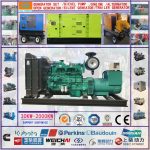Introduction
Diesel generators are commonly used in various industries and applications to provide backup power during outages or as a primary power source in remote locations. Performance testing of diesel generators is crucial to ensure their reliability, efficiency, and compliance with regulatory standards. In this article, we will explore the importance of performance testing for diesel generators, the key parameters that are tested, and the methods used for conducting these tests.
Importance of Performance Testing
Performance testing of diesel generators is essential to verify that the system will function as intended during critical situations. These tests help identify any potential issues or weaknesses in the generator that could lead to failures when it is needed most. By conducting 150kw diesel generator for remote humanitarian projects , operators can ensure the reliability and efficiency of the generator, minimize downtime, and prevent costly repairs or replacements.
Performance testing also plays a critical role in ensuring compliance with industry standards and regulations. Many industries, such as healthcare, data centers, telecommunications, and manufacturing, have strict requirements for backup power systems to maintain operations during power outages. Performance testing helps demonstrate that the diesel generator meets these standards and can provide the necessary power output when required.
Key Parameters Tested
Several key parameters are typically tested during performance testing of diesel generators to assess their overall performance and reliability. Some of the most important parameters include:
1. Power Output: One of the primary parameters tested is the power output of the diesel generator. This involves measuring the actual electrical power produced by the generator under different load conditions to ensure it meets the specified rating.
2. Voltage Regulation: Voltage regulation refers to the ability of the generator to maintain a stable output voltage within specified limits as the load changes. Voltage regulation testing is essential to ensure that the generator can deliver consistent and reliable power to connected loads.

3. Frequency Regulation: Frequency regulation is another critical parameter that is tested to ensure the generator can maintain a stable output frequency within acceptable limits. Deviations in frequency can affect the performance of connected equipment and lead to potential damage.
4. Fuel Consumption: Performance testing also involves measuring the fuel consumption of the diesel generator under various load conditions. This helps assess the efficiency of the generator and determine its operating costs over time.
5. Start-Up Time: The start-up time of the generator is another important parameter that is tested during performance testing. This includes evaluating how quickly the generator can start and reach full power output after a power outage or manual start.
Methods for Conducting Performance Testing
Performance testing of diesel generators can be conducted using various methods and procedures to ensure accurate and reliable results. Some of the common methods for conducting performance testing include:
1. Load Bank Testing: Load bank testing involves connecting an external load bank to the generator to simulate real-world load conditions. This test allows operators to assess the performance of the generator under varying load levels and verify its capacity to handle peak loads.
2. No-Load Testing: No-load testing is performed to evaluate the idle performance of the generator without any connected loads. This test helps assess the idle speed, voltage, and frequency regulation of the generator under no-load conditions.
3. Full-Load Testing: Full-load testing involves applying the maximum rated load to the generator to determine its performance at full capacity. This test helps verify the power output, voltage regulation, frequency regulation, and overall efficiency of the generator under maximum load conditions.
4. Transient Response Testing: Transient response testing is conducted to evaluate how quickly the generator can respond to sudden changes in load demand. This test helps assess the stability and reliability of the generator during load variations.
5. Fuel Consumption Testing: Fuel consumption testing is performed to measure the amount of fuel consumed by the generator under different load conditions. This test helps determine the fuel efficiency of the generator and calculate its operating costs.
Conclusion
Performance testing of diesel generators is a critical process that ensures the reliability, efficiency, and compliance of these backup power systems. By testing key parameters such as power output, voltage regulation, frequency regulation, fuel consumption, and start-up time, operators can verify the performance of the generator under various operating conditions. Using methods such as load bank testing, no-load testing, full-load testing, transient response testing, and fuel consumption testing, operators can assess the overall performance and reliability of the diesel generator. Overall, performance testing is essential to ensure that diesel generators can provide reliable backup power when needed and meet the stringent requirements of various industries and regulatory standards.
